Wake-up Call: Last Male Northern White Rhino Dead
Sudan, the last Northern White Rhino male, died yesterday.
Conservationists expected the death. Sudan, an elderly rhino, developed an infection on his back leg. He leaves the last two Northern White Rhinos, two females, behind. Sudan and the two remaining females were unable to produce children. However, scientists harvested sperm and eggs. Hopefully, conservationists successfully use IVF to bring the species back someday, using Southern White Rhinos as surrogates.
The Northern White Rhino is the second rhino species to face almost certain extinction. The Western Black Rhino went extinct in 2013. One thousand Eastern Black Rhino currently roam Kenya, Rwanda, and Tanzania. Outside of rhinos, seven species are thought to be extinct all over the world. As of 2017, 27 new species are considered possibly extinct or extinct in the wild. With species smaller and less researched than rhinos, it is hard to tell when a species is truly extinct.
The IVF procedure is not guaranteed to work, and it will cost more than nine million dollars. Bringing the Northern White Rhino back is much more expensive than protecting it in the first place would have been. For almost every species, the cost of prevention is much cheaper than what it takes to turn back the clock.
What We Can Do About It
This should be a wake-up call. While poachers threaten rhinos the most, other species disappear forever because of climate change and the pollution caused by the extraction and burning of fossil fuels. As temperatures rise around the world, ecosystems working seamlessly for thousands and millions of years are starting to unravel. As oceans warm, acidify by absorbing increasing amounts of carbon dioxide, and are over-fished, aquatic species disappear. As ice caps melt, islands and coastal regions are flooded, unique ecosystems are ruined.
Solar is part of the solution to save the world. The investment into a solar array not only shrinks a power bill, it helps protect the organisms we share this earth with. Do your part today.
Keep Reading:
National Geographic: After Last Male’s Death, Is the Northern White Rhino Doomed?
2017 Possibly Extinct and Possibly Extinct in the Wild Species Table
- Published in Uncategorized
The Unexpected Jobs Solar Brings: Solar Shepherds
Something new is giving solar a hand, and solar is returning the favor. Solar shepherds are leading in a useful flock.
But Why?
One of the solar industry’s biggest cost is landscaping around solar farms. Tall vegetation might impede energy production if it shades the panels, but the panels are placed to maximize energy production, not fit a lawnmower. One rock lobbed from a lawnmower blade, and a panel is ruined. Most of the work is done with weed eaters. All around, it is just a hassle.
The Smithsonian reported on a technique beyond your average weedeating. Sheep are creating innovation. Small enough to fit between the solar panels, gentle enough not to break anything, and hungry enough to eat the grass, they are the perfect lawn care service for solar farms. Rotating herds of grazing sheep from solar farm to solar farm allows the panels to produce energy unhindered and safe from debris slung by a mower. Solar shepherds own the sheep and rotate them around different solar farms. It is making a splash in the solar world. Several states already take advantage of sheep (and support local agricultural business).
Individuals lucky enough to own land and sheep can lease their land to a utility or large company looking to go green, like Apple or Ikea, and have their herd make sure the land stays ideal for solar. A savvy rancher in Hawaii was able to work that deal. Even if people do not want to lease land, there are ways to utilize their sheep.
Helping Local Business
North Carolina is home to Sun Raised Farms, a solar farms maintenance contractor. Sun Raised Farms uses the herds of local farmers. In a time of struggle for small farms, the opportunity to make income from more than one source is vital.
Solar growing in North Carolina helps other industries too. Hopefully, solar and agriculture have a long profitable symbiosis.
- Published in Uncategorized
Solar Panel Tariff Outcome Not As Bad As Expected
This week, President Trump created a solar panel tariff. The first year will see a 30% tariff.
Background
In May 2017, American solar panel manufacturer Suniva, later joined by SolarWorld, petitioned the United States International Trade Commission (ITC) to take action restoring the damage done to the American solar panel manufacturers by imported solar panels. The ITC agreed after an investigation, and made suggestions to President Trump who agreed with the suggestions on Jan. 22.
While American solar panel manufacturers benefited, the decision harmed the rest of the solar industry. With higher costs, the number of jobs provided by the growing American solar industry will drop.
Bright Side
However, consequences may not be as bad as they sound. The solar panel tariff will last four years and drop five percent each year. By 2021, the last year of the tariff, it will only be 15 percent. Even with the tariff, solar panel prices will continue to drop as they have for years with each improvement of Chinese and Korean solar panel manufacturing. The tariff may not be noticeable by the time 2021 rolls around.
This is partly due to the percentage-based tariff rather than a fixed amount of money. As foreign solar panel prices drop, so will the tariff. Currently, the tariff adds 10-12 cents per watt in year one, which is a 3-4 percent increase for a resident looking to install an array. By the end of the tariff, it should only be adding 4-5 cents which is less than a 2 percent increase in price.
Though this was not the answer the solar industry hoped for, the impact may not be as bad as was first thought. With a North Carolina rebate program in the works, now could actually be the perfect time to install a solar array.
Read more about it:
How the 2018 U.S. solar tariff will impact the price you pay
- Published in Solar News
7 Solar Inventions You Might Have Overlooked!
1) Solar Dancing Toys:
Need a pick me up? These solar powered dancing flowers are sure to bring a smile to anyone’s face. Flowers aren’t your style? No worries! Click to see a complete selection of solar dancing toys including: The Pope, Bugs, Hawaiian Dancers, Animals, and more!
2) Solar Powered Window Socket:
Because when you are on the go and the outlet is too far away, stick your solar powered window socket anywhere you want! Airports, cars, bedrooms, or even your local supermarket- Charge your phone on the go.
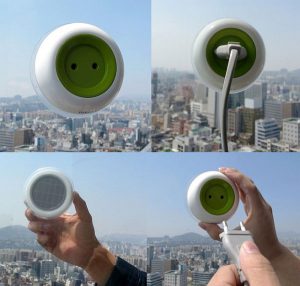
Source: http://www.blueosa.com/the-window-socket-solar-powered-plug-sticks-to-window-powers-anything/
3) This Solar Powered Boat:
Follow this boat that’s on a mission to promote the preservation of the earth’s water! The most precious resource on earth has ben compromised by crude oil and plastics. With an array large enough to spin some cart-wheels, or jump some rope, the system is powerful enough to run for 3 days without any sunlight.
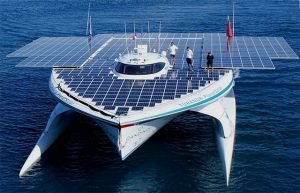
Source: http://www.raceforwater.com/r4w_odyssey_2017_2021/a_pioneering-100-energy-self-sufficient-vessel
4) Solar Powered Street Signs
What is Asheville to do when enough people ignore the stop signs? Stick a solar panel on top that power up some flashing lights around the sign. Maybe if the citizens wont stop for the sign, they will at least stop to see the pretty solar panel.
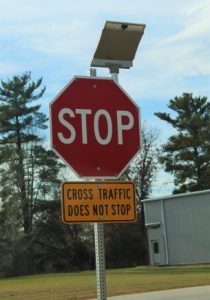
Source: https://www.google.com/search?q=solar+powered+stop+sign&tbm=isch&source=lnt&tbs=sur:fc&sa=X&ved=0ahUKEwjzz_yD0O7YAhXLJt8KHQQXDSIQpwUIHw&biw=1920&bih=925&dpr=1#imgrc=PLLWs2ScOaa2OM:
5) Solar Roadway®
While this unique invention is still in the works, designers have produced a few prototypes and have high hopes for the future of power generation.
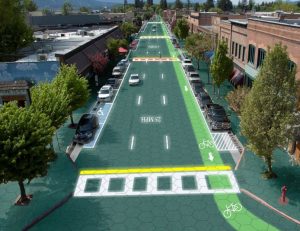
Source: http://www.solarroadways.com/Home/Index
6) The Solar Lawn Mower
Search “Solar Powered Lawn Mower” on any search engine and you will be surprised. We are all trying to cut our carbon footprints and save some money any way we can but buying a solar powered lawn mower is taking it to the next level.
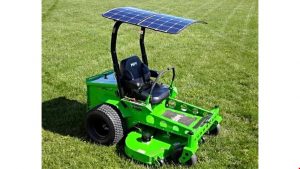
Source: http://www.lawnandlandscape.com/article/ll-050516-meangreen-mower-solar/
7) Wearable Solar Inventions: Dresses, bikinis, Eye Glasses, Hats, You name it, its out there.
Talk about pushing boundaries, we now have solar powered clothing that can charge our electronics on the go! Solar light-up dresses, cell phone charging eye glasses and backpacks, as well as solar powered fan-hats.

Source: https://www.amazon.com/Kool-Breeze-Solar-Hat-Cowboy/dp/B00PA0A23U
- Published in Uncategorized
Solar Rebate Program Up For Approval
More affordable solar arrays will be possible for North Carolinians soon. Duke Energy submitted a solar rebate program proposal to the North Carolina Utilities Commission (NCUC) on Jan. 22.
North Carolina leads the nation in solar, coming second only to California in the amount of solar installed in 2016. In July 2017, North Carolina legislature required Duke to create a rebate program with House Bill 589 or Competitive Energy Solutions Law for North Carolina. Duke responded with a $62 million proposal. When approved, the program will run until 2022 keeping North Carolina in the front of the solar industry. The program comes from two years of collaboration between Duke Energy and N.C. Sustainable Energy Association.
The Details
Residents participating in the program receive 60 cents per watt up to 10 kW, meaning residents will be reimbursed for $6,000 of their array. Corporate participants get 50 cents per watt, and non-profits collect 75 cents per watt, both up to 100 kW providing payouts as high as $50,000 for commercial customers and as much as $75,000 for non-profit customers. Those who installed panels after Jan. 1, 2018, are eligible for the program.
The program limits rebates to 20 MW, split evenly between customers of Duke Energy Carolinas and Duke Energy Progress. 5MW for each district are allocated to residents, and 2.5 MW are allocated to non-profits. If NCUC approves the proposal, applications are due to the applicable utility 90 days after installation.
If customers wish to use solar without installing it, there is a leasing option where individuals lease panels from another source. Later in 2018, other programs will be added. Shared Solar enables customers without an array to use energy from a close solar facility. Green Source Advantage expands a Duke Energy Carolina program allowing customers consuming large amounts of energy to offset that with solar.
About SolFarm Solar: Starting in 2012, Mike Diethelm began installing solar PV systems on residential and commercial buildings under the name SolFarm Solar Co. with the intention of doing something great for the earth. His goal is to leave his son with something that was better and cleaner for the environment. Driving a Leaf around town, and a bio-diesel en route to solar jobs, SolFarm has evolved into Asheville’s most trusted and highly recommended solar installation company.
Links:
https://www.solarpowerworldonline.com/2018/01/duke-energy-north-carolina-solar-rebates/
- Published in Logistic, Solar News
Can Your Home Power Your Car?
Can My Home Solar System Produce Enough Power To Charge My Car?
The simple answer is yes. Depending on the electric car you choose, your solar installation company can design a solar array to meet your lifestyle’s needs.
North Carolina local, Ezra Dryer, produced an article in a 2016 issue of Popular Mechanics after testing how his solar array would hold up in producing enough electricity to power 3 electric vehicles: Tesla X, Gem e4, and the Mitsubishi i-MiEV.
He concludes the article by posing the question, “Would you prepay for three years of gas if it meant that you would never pay for it again?” Turns out that the payback on his solar array went from 8 years to 3 after trading in his gas guzzling vehicle for an electric vehicle.
Imagine pulling up to your local service station and filling your tank for free. Dryer points out the inconsistencies between the free electric charging stations all over the country and how we are required to pay for every ounce of gasoline. Electricity isn’t free. So where does it come from? Who pays for it? You sure don’t.
Its time to sit down and do the math. The rebates are out, and they won’t be around forever. How much can you save by investing in solar?
What size PV system does my home need to power my vehicle?
Saving money and trying to achieve an emission free lifestyle are one in the same. Solar panels and electric cars are a match made in heaven! Solar prices are falling and with the new incentives and rebates, solar is more affordable then ever. Waiting to install solar could hinder your ability to take advantage of current solar incentives. Not to mention, the longer you wait, the more you are paying into your current electric providers pocket.
While electric cars cannot be measured by the standard MPG, the U.S. Department Of Energy uses a similar system- MPGe. To find the right fit, you can compare electric cars at FuelEconomy.com.
Prepare yourself to speak with your local solar installers. Gather information on your current energy usage, and think about your future energy usage. Figure out the average miles you drive and determine how much MPGe you will need to meet that goal. With this information you can speak with a solar installation company to figure out what size system is right for your needs.
If this is all too much at once, there are other options. It is possible to install a solar array on your roof with the intention of expanding it in the future. Upgrades to your solar system are not complicated and would allow you time to adjust to life in the solar industry. Start by placing a call to your local solar installation company, SolFarm Solar, and researching which electric car is the best for you.
We’ll take it from there.
- Published in Uncategorized

















